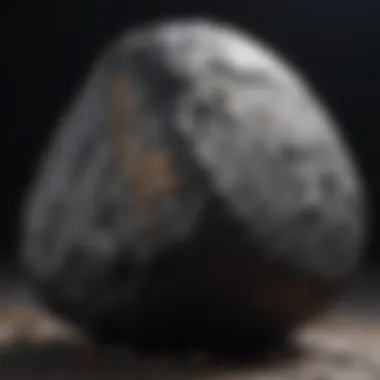Unlocking the Mysteries of Identifying Smooth Black Rocks with Precision


Rock and Fossil Identification
Smooth black rocks hold a mystique all their own in the realm of geological wonders. Their smooth texture and dark hue set them apart from other rocks, captivating the eye of collectors and enthusiasts alike. Understanding how to identify these unique specimens involves delving into their key characteristics and features. From the elemental composition to the distinctive texture patterns, smooth black rocks offer a wealth of information for those keen on unraveling their secrets.
Collecting Tips and Techniques
When it comes to collecting smooth black rocks, precision and technique play pivotal roles in the acquisition of prized specimens. The search for these geological treasures often leads enthusiasts to prime collecting sites, where the careful extraction of specimens demands finesse and patience. By applying best practices in collecting, collectors can enhance their chances of uncovering exceptional smooth black rocks while also respecting the natural environment and preserving the integrity of the specimens.
Preservation and Display
Preserving the allure of smooth black rocks involves employing meticulous techniques to maintain their natural beauty and integrity. From proper storage methods that shield the specimens from environmental factors to creative display ideas that showcase their unique features, collectors can ensure that these geological wonders continue to captivate viewers for generations to come. The art of preservation and display elevates the appreciation of smooth black rocks, transforming them from mere specimens into artistic marvels that tell stories of geological history.
Geological Insights
Introduction
Smooth black rocks, a marvel of geological wonders, hold an allure that piques the curiosity of rock and fossil collectors worldwide. This article serves as a comprehensive guide to unlocking the secrets of identifying these enigmatic specimens, shedding light on their unique characteristics and significance in the realm of geology. By delving into the intricate world of smooth black rocks, readers will gain a profound appreciation for the beauty and complexity that lies within these seemingly ordinary yet extraordinary formations.
Exploring the Fascinating World of Smooth Black Rocks
Understanding the allure of smooth black rocks
Smooth black rocks exude a magnetic charm that transcends their simplistic appearance. The allure of these rocks lies in their enigmatic darkness, hinting at unseen depths and mysteries waiting to be uncovered. The smoothness of their surfaces adds to their appeal, inviting touch and exploration. Rock enthusiasts are drawn to the unparalleled elegance of smooth black rocks, a testament to the beauty that nature can sculpt over time.
Significance of identifying smooth black rocks
Identifying smooth black rocks is not merely a quest for geological knowledge; it is an enthralling journey into Earth's history and natural processes. The ability to discern the unique characteristics of these rocks enables collectors to distinguish between various types and origins, deepening their understanding of geological formations. Furthermore, pinpointing these smooth black rocks opens avenues for discovering rare specimens and understanding the geological forces that have shaped our planet. Thus, the significance of identifying smooth black rocks extends beyond mere identification; it enriches our appreciation of the intricate tapestry of the Earth's crust and its hidden treasures.


Characteristics of Smooth Black Rocks
Smooth black rocks possess distinctive characteristics that are essential in identifying and appreciating these geological wonders. Understanding the texture, color, luster, density, and weight of smooth black rocks is crucial in differentiating them from other rocks. These characteristics not only aid in identification but also provide insights into their geological history and formation processes.
Texture
Smoothness as a defining feature
Smoothness is a defining characteristic of black rocks, symbolizing their unique composition and often indicating specific formation conditions. The smooth texture of these rocks is a result of erosion and natural weathering over time, imparting a sleek appearance that sets them apart from rougher rocks. This feature contributes to their allure and appeal to rock enthusiasts, highlighting the elegance of their aesthetic.
Exploring variations in textures
Despite the overarching smoothness, black rocks can exhibit variations in texture, ranging from silky finishes to slightly rough surfaces. These textural differences may suggest diverse mineral compositions or distinct geological settings where the rocks originated. By exploring these variations, collectors can discern subtle details that enhance their understanding and identification of different smooth black rock types.
Color and Luster
Understanding the black hue
The deep black hue of smooth black rocks is a defining characteristic that showcases their rich mineral content, such as high levels of basalt, obsidian, or magnetite. This darkness reflects their dense composition and unique geological origins, underscoring their enigmatic beauty. Understanding the significance of this black hue is pivotal in accurately identifying and appreciating smooth black rocks.
Examining luster levels
Luster refers to the reflective quality of a mineral's surface, indicating how light interacts with its texture. Smooth black rocks can exhibit a range of luster levels, from matte to glossy finishes, depending on their mineral composition and crystalline structure. Examining these luster variations provides insights into the rock's formation conditions and can aid collectors in differentiating between different types of smooth black rocks.
Density and Weight
Assessing density for identification
The density of smooth black rocks is a crucial factor in their identification, as it reveals information about their mineral composition and formation processes. By assessing the density of a rock specimen, collectors can infer its durability, strength, and potential geological significance. This characteristic helps in categorizing smooth black rocks and understanding their unique properties.


Weight variations in different types
Smooth black rocks can vary significantly in weight depending on their mineral content and porosity. Heavier rocks may indicate higher concentrations of metals or denser minerals, while lighter rocks could suggest a more porous or volcanic origin. Understanding these weight variations assists collectors in organizing and classifying their smooth black rock collection based on these physical attributes.
Formation and Composition
The section on Formation and Composition in this article plays a crucial role in unraveling the secrets of identifying smooth black rocks. By delving into the geological origins and composition of these rocks, readers can gain a deeper understanding of the intricate processes that lead to their formation.
Geological Origins
Natural processes shaping black rocks
The natural processes shaping black rocks are a fundamental aspect of this article, shedding light on the forces that have molded these unique geological wonders. Exploring the specific mechanisms behind the formation of smooth black rocks provides valuable insights into their journey through time. Understanding the key characteristics arising from these natural processes is essential for rock enthusiasts seeking to distinguish and appreciate the beauty of these formations. Exploring the nuances of natural processes shaping black rocks helps uncover the complexities of their composition and the environmental factors that influenced their development.
Common locations for finding smooth black rocks
Discussing the common locations for finding smooth black rocks offers practical guidance to enthusiasts eager to uncover these treasures. Highlighting the key characteristic features of these locations provides valuable information for rock and fossil collectors keen on expanding their collections. By detailing the advantages and disadvantages of different finding locations, readers can refine their search strategies and enhance their chances of discovering exquisite specimens.
Composition
Mineral content analysis
The analysis of mineral content in smooth black rocks is a cornerstone of this article, offering crucial insights into their geological makeup. By examining the specific minerals present in these rocks, collectors can gain a deeper appreciation of their composition and origin. Highlighting the key characteristics derived from mineral content analysis equips readers with the knowledge needed to differentiate between various types of smooth black rocks and understand their geological significance.
Identifying unique compositions
Exploring the identification of unique compositions in smooth black rocks elevates the reader's understanding of the diverse nature of these geological formations. By emphasizing the distinctive features of different compositions, this section enables enthusiasts to appreciate the individuality and rarity of certain rock specimens. Delving into the advantages and disadvantages of identifying unique compositions enriches the learning experience, guiding readers towards a more nuanced appreciation of these intricate geological wonders.
Methods of Identification


In the realm of smooth black rock identification, the methods employed play a crucial role in unraveling the mysteries these geological wonders behold. The significance of employing meticulous identification methods cannot be overstated, as it forms the cornerstone of distinguishing one smooth black rock from another. By delving into the specific elements and benefits of the methods used for identification, enthusiasts and collectors can gain a profound understanding of the intricate processes involved in discerning the unique characteristics of smooth black rocks.
Visual Inspection
Key visual cues for identification
When embarking on the journey of identifying smooth black rocks, one of the pivotal aspects to consider is the key visual cues that set them apart. These cues act as the guiding light, allowing collectors to differentiate between various types of smooth black rocks with precision. The unique feature of key visual cues lies in their ability to provide nuanced details about the texture, color, and luster of a rock, serving as the foundation for accurate identification. By honing in on these specific characteristics, enthusiasts can refine their knowledge and appreciation of smooth black rocks, enriching their collection with rare and distinctive specimens.
Using magnification tools
Employing magnification tools in the identification process offers a deeper dive into the intricate details encapsulated within smooth black rocks. These tools serve as amplifiers, unveiling minuscule features that are otherwise imperceptible to the naked eye. By magnifying the textures, colors, and impurities present in the rocks, collectors can detect subtle nuances that facilitate precise identification. While magnification tools enhance the accuracy of examination, they also bring to light the finer intricacies of smooth black rocks, elevating the identification process to a more refined and thorough level.
Laboratory Analysis
In-depth testing procedures
Delving into the realm of laboratory analysis opens doors to in-depth testing procedures that provide a comprehensive understanding of the composition and structure of smooth black rocks. These procedures involve sophisticated testing methods that unveil the mineral content and geological history embedded within each specimen. By scrutinizing the chemical composition and physical properties through rigorous testing, collectors can unravel the hidden mysteries of smooth black rocks, paving the way for a deeper appreciation of their geological significance.
Importance of professional analysis
The importance of entrusting smooth black rock analysis to professionals cannot be emphasized enough, as their expertise adds layers of precision and accuracy to the identification process. Professional analysis brings forth a wealth of knowledge and experience, guiding collectors through the complexities of rock identification with finesse. By relying on professionals for analysis, enthusiasts can ensure meticulous examination and interpretation of findings, leading to a more informed and enriched understanding of the smooth black rocks gracing their collection.
Conclusion
Smooth black rocks hold a mesmerizing allure that goes beyond their aesthetic appeal. By delving into the world of smooth black rock identification in this comprehensive guide, readers can gain a profound understanding of these geological wonders. The conclusion section serves as a final reflection, emphasizing the significance of recognizing and appreciating the subtle characteristics that define smooth black rocks. Understanding these key elements not only enhances one's geological knowledge but also enriches the overall experience of exploring and studying these captivating natural formations. Through this article, readers are encouraged to embrace the beauty of geological diversity and continue their journey of discovery.
Enhancing Your Appreciation for Smooth Black Rocks
Embracing the beauty of geological diversity
Embracing the diverse beauty of geological formations allows enthusiasts to delve deeper into the intricate world of smooth black rocks. Appreciating the varying textures, colors, and compositions of these rocks contributes to a more profound understanding of their origins and geological significance. By immersing oneself in the mesmerizing beauty of smooth black rocks, individuals can develop a heightened sense of appreciation for the earth's diverse processes and natural creations. Embracing geological diversity broadens horizons and sparks curiosity, fostering a deeper connection with the natural world.
Continuing the exploration journey
Continuing the exploration journey offers enthusiasts the opportunity to expand their knowledge and appreciation of smooth black rocks. This ongoing quest for discovery allows individuals to uncover new specimens, explore different formations, and connect with fellow rock and fossil enthusiasts. By continuing to investigate and analyze smooth black rocks, collectors can refine their identification skills, document their findings, and contribute to the collective knowledge within the scientific and enthusiast communities. The exploration journey is a never-ending pursuit of knowledge and discovery, fueled by curiosity and the desire to unravel the mysteries hidden within these cherished geological treasures.







